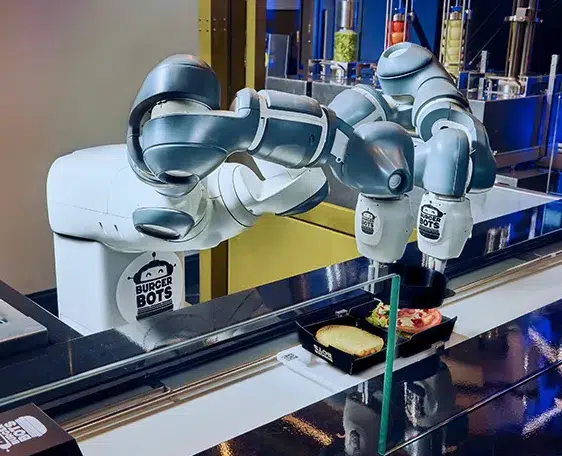
Burger Bot in California
A California burger restaurant turns to automation by integrating robots into its patty assembly line, marking a significant shift in how fast food is prepared and served. We’ve seen it before but this is the latest iteration. The intent is to enhance efficiency, consistency, and overall customer experience while addressing labor shortages in the food industry.
Table of Contents
ToggleKey Points
- Introduction of Robotics:
- The restaurant has introduced robotic technology to automate the process of assembling burger patties. This move is part of a broader trend in the fast-food industry, where automation is increasingly seen as a solution to rising labor costs and staffing challenges.
- Efficiency and Consistency:
- By utilizing robots, the restaurant aims to improve the speed and consistency of its food preparation. Robots can work continuously without breaks, ensuring that patties are cooked and assembled uniformly, which is crucial for maintaining quality standards.
- Addressing Labor Shortages:
- The fast-food industry has been grappling with labor shortages, exacerbated by the COVID-19 pandemic. The introduction of robots helps mitigate this issue by reducing reliance on human labor for repetitive tasks, allowing staff to focus on customer service and other critical areas.
- Customer Experience:
- The integration of robotics is not just about efficiency; it also enhances the customer experience. With faster service times and consistent product quality, customers are likely to have a more satisfying dining experience. The restaurant aims to create a seamless interaction between technology and human staff.
- Technological Innovation:
- The robots used in the assembly line are equipped with advanced technology that allows them to handle various tasks, from cooking patties to assembling burgers. This level of automation represents a significant investment in technology, reflecting the restaurant’s commitment to innovation.
- Future of Fast Food:
- The article discusses the potential implications of this shift towards automation in the fast-food sector. As more restaurants adopt similar technologies, the landscape of food service may change dramatically, with robots playing a central role in operations.
- Challenges and Considerations:
- While the benefits of automation are clear, there are challenges to consider. The initial investment in robotic technology can be substantial, and there may be concerns about job displacement for workers. The restaurant emphasizes that robots are intended to complement human staff rather than replace them.
- Community Response:
- The local community has shown interest in the restaurant’s innovative approach. Many customers are excited about the prospect of faster service and higher-quality food, while others express curiosity about how robots will change the dining experience.
Conclusion
The California burger joint’s decision to incorporate robots into its patty assembly line represents a significant step towards the future of fast food. By enhancing efficiency, addressing labor shortages, and improving customer experience, the restaurant is positioning itself at the forefront of a technological revolution in the food industry. As automation becomes more prevalent, it will be interesting to see how it shapes the dynamics of fast food and the broader restaurant landscape.
